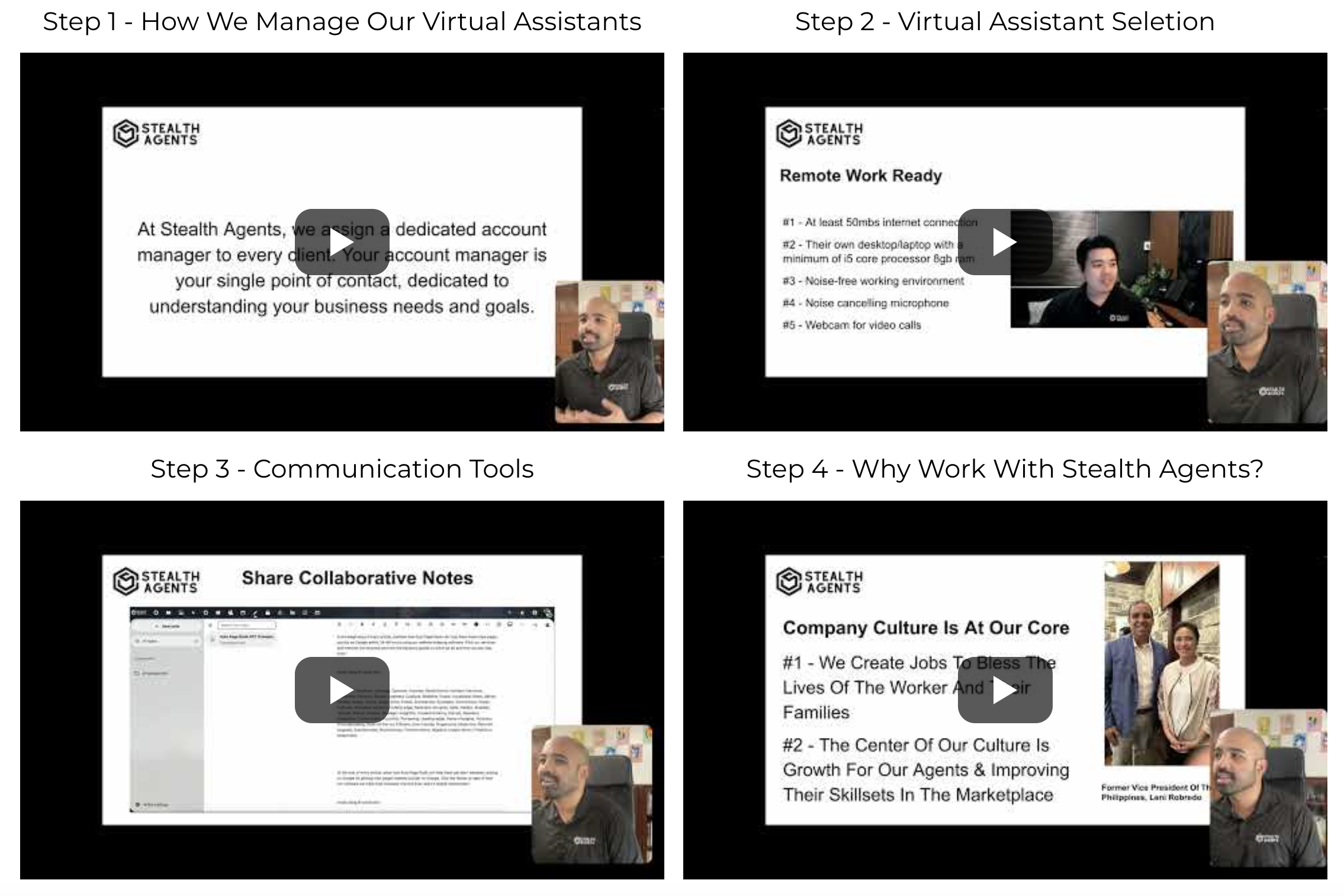Choosing the right tools can make all the difference in productivity and collaboration. Slack and Airtable each have unique strengths that cater to different business needs.
Slack shines as a robust communication platform, enabling real-time messaging, channels for organized conversations, and seamless integration with countless apps to streamline workflow.
On the other hand, Airtable offers a versatile project management solution. It blends the simplicity of spreadsheets with the power of databases to track projects, manage data, and collaborate effectively across teams.
While Slack enhances team communication, Airtable excels in organizing and visualizing project data. Understanding these distinctions is crucial for businesses looking to optimize their work processes and select tools that best fit their operational needs.
This resource provides an in-depth comparison to help you clarify these choices. Created and curated by Stealth Agents, it aims to guide you toward making informed decisions that align with your strategic goals.
What is Slack?
Slack is a communication platform designed to enhance collaboration within teams and businesses by providing a centralized messaging and file-sharing space.
It allows users to create channels for different topics, projects, or teams, ensuring organized and focused discussions. With real-time messaging capabilities, Slack enables immediate interaction, reducing the need for lengthy email chains.
*advertisement*
Tired & Overwhelmed With Administrative Tasks?
Hire A Top 1% Virtual Assistant From Stealth Agents!

Sign Up Below & Hire A Top 1% Virtual Assistant
Rated 4.7 Stars Serving Over 2,000+ Customers.
Hire Top 1% Virtual Assistants For $10-$15 Per Hour
Ask About Our 14 Day Trial!
*advertisement*
The platform also integrates with various applications, streamlining workflows and consolidating multiple tools into one interface.
Beyond messaging, Slack supports video calls and file sharing, making it a versatile tool for remote and in-office teams.
Key Features:
- Channels: Organize conversations by topic, project, or department, allowing for focused and efficient communication.
- Direct Messaging: Provides private conversation threads between individuals or small groups to discuss specific issues.
- Integration with Apps: It seamlessly connects with numerous third-party apps, such as Google Drive, Trello, and Zoom, to enhance productivity.
- Searchable History: Offers a comprehensive record of messages and files, enabling users to quickly retrieve past communications.
- Video and Voice Calls: Facilitates direct communication beyond text, supporting collaboration through meetings and discussions.
Pros:
- Enhanced Communication: Slack simplifies communication with its real-time messaging and organized sales channels business, promoting efficient information exchange.
- Collaboration Made Easy: With integration capabilities, teams can collaborate on documents and projects within the app, reducing the need to switch between different tools.
- Accessibility: Available on multiple devices, Slack ensures users can stay connected whether they are in the office or on the go.
- User-Friendly Interface: Its intuitive design makes it easy for users to navigate and utilize its features without extensive training.
- Customizable Notifications: Users can tailor notification settings to avoid distractions and focus on what’s most important to them.
Cons:
- Information Overload: With numerous channels and messages, users may experience difficulty managing and prioritizing information.
- Dependency on Internet: As a cloud-based tool, Slack requires a stable internet connection, which can be a drawback in areas with connectivity issues.
- Cost for Premium Features: While the basic version is free, advanced features require a subscription, which might be costly for some small businesses.
- Learning Curve for New Users: Newcomers might find the platform overwhelming at first, requiring time to get accustomed to its full range of functionalities.
- Potential for Distraction: With constant notifications and conversations, users might struggle to maintain focus on their tasks.
What is Airtable?
Airtable is a versatile project management and database tool designed to help teams and businesses easily organize, track, and manage various projects and data.
It combines a spreadsheet’s simplicity with a database’s functionality, allowing users to create customized workflows that suit their specific needs.
Its user-friendly interface, Airtable, enables teams to collaborate effectively by sharing and editing information in real-time.
The platform supports various data types, making it ideal for managing everything from simple task lists to complex project timelines. Additionally, Airtable integrates with many popular tools, streamlining processes and enhancing productivity.
Key Features:
- Customizable Templates: Offers a variety of templates for different use cases, providing a head start on setting up databases and workflows.
- Views and Layouts: Allows users to switch between grid, calendar, kanban, and gallery views for data visualization in the most effective way for their project.
- Automations: Helps streamline repetitive tasks by automating actions based on specific triggers, saving time and reducing manual effort.
- Integration with Apps: Connects seamlessly with other apps such as Slack, Google Workspace, and Zapier to enhance functionality and consolidate tools.
- Real-Time Collaboration: Enables team members to work together simultaneously, ensuring everyone is on the same page with the most current data.
Pros:
- Flexibility and Customization: Airtable’s flexibility allows users to tailor databases and workflows to fit unique project requirements, making it adaptable to various industries.
- Ease of Use: The intuitive design and drag-and-drop interface make it accessible to users with different levels of technical expertise.
- Enhanced Collaboration: With real-time collaboration features, teams can work together smoothly, reducing communication gaps and improving productivity.
- Comprehensive Data Management: Supports a wide range of data types and complex relationships, offering robust solutions for data organization.
- Scalability: Ideal for both small teams and larger enterprises, Airtable can grow with your organization, adapting to increasing project demands.
Cons:
- Pricing for Advanced Features: Some of the more powerful features, such as increased storage and advanced integrations, are only available in higher-priced plans.
- Complexity for New Users: While flexible, Airtable can be overwhelming for beginners who are not familiar with database concepts, requiring a learning curve.
- Limited Offline Access: Airtable is primarily cloud-based, so users may face challenges accessing and editing data without an internet connection.
- Performance with Large Datasets: Handling large volumes of data can sometimes slow down performance, which might be an issue for data-heavy operations.
- Feature Limitations on Free Plan: The free version offers limited features and capacity, which may not suffice for businesses requiring extensive project management tools.
Slack vs Airtable: Detailed Features Comparison
1. Communication Capabilities
In the Slack vs Airtable debate, communication is where Slack truly excels. As a platform designed specifically for communication, Slack provides real-time messaging, allowing teams to interact instantly.
It offers organized channels for different projects or topics, keeping conversations focused and accessible.
Airtable, while primarily a project management tool, does facilitate communication through comments and mentions within its interface but lacks the depth and immediacy of Slack’s messaging system.
Therefore, Slack is typically the preferred choice for teams prioritizing communication.
2. Project Management Features
When comparing Slack vs Airtable, Airtable stands out as a robust project management tool.
It provides a flexible, spreadsheet-like interface that can transform into a powerful database, enabling users to track and manage projects with customizable templates and views.
Slack, on the other hand, is not designed for project management but can integrate with other tools to help streamline project workflows.
However, Airtable’s ability to manage complex data sets and project timelines natively makes it more suitable for businesses with intricate project management needs.
3. Integration and Automation
Slack vs Airtable offer strong integration capabilities, allowing them to connect with numerous third-party applications.
In the Slack vs Airtable analysis, Slack’s strength lies in its ability to seamlessly integrate with apps like Google Drive, Trello, and Zoom, which enhances communication and workflow efficiency.
Airtable also offers robust automation features, enabling users to set triggers and actions to automate routine tasks and integrate with tools like Zapier.
This makes Airtable particularly valuable for users looking to streamline processes without manual intervention.
4. User Interface and Experience
The Slack vs Airtable comparison reveals distinct differences in user interface design and experience.
Slack’s interface is mainly focused on providing a clean, intuitive space for communication, with easily navigable channels and threads.
Airtable, however, presents a more complex interface due to its database functionalities, which might require a learning curve for new users.
Despite this, Airtable’s drag-and-drop features and customizable views offer a user-friendly experience once mastered, catering to diverse project management requirements.
5. Collaboration and Teamwork
Regarding collaboration, the Slack vs Airtable discussion highlights how each tool supports teamwork in different ways.
Slack’s real-time messaging and call features facilitate dynamic team interactions, making it ideal for immediate quality customer feedback and discussions.
Airtable promotes collaboration through shared databases where team members can work simultaneously on projects, ensuring everyone is updated with the latest information.
While both tools support collaboration, Slack is more communication-oriented, whereas Airtable focuses on collaborative data and project management.
How Stealth Agents Choose Slack vs Airtable?
When Stealth Agents evaluate whether to choose Slack vs Airtable for their operations, they consider a variety of factors that align with their specific needs and strategic goals.
Communication needs are paramount, and Slack offers a robust platform for instant messaging and real-time collaboration, ideal for teams requiring constant connectivity and quick business decision-making strategies processes.
On the other hand, Airtable shines with its powerful database management and project tracking capabilities, making it a preferred choice for operations that demand structured data organization and comprehensive project views.
Stealth Agents weigh each platform’s integration capabilities. Slack boasts extensive app integrations that enhance its functionality within existing workflows. In contrast, Airtable’s integrations often focus on data management tools that streamline project execution.
Another consideration is the user interface; Slack’s intuitive chat interface is favored for straightforward communication, while Airtable’s spreadsheet-like interface is beneficial for visually managing tasks and resources.
Specific scenarios, such as daily team meetings or urgent updates, may see a preference for Slack due to its immediacy, whereas strategic planning business sessions or resource allocation might lean towards Airtable.
Ultimately, the decision hinges on balancing the need for dynamic communication and the requirement for detailed project visualization, ensuring that Stealth Agents leverage the strengths of each platform to suit their operational demands.
By assessing these factors, Stealth Agents can effectively harness the capabilities of either tool to enhance their productivity and collaboration efforts.
If you are also looking for a virtual assistant, Stealth Agents is ready to help. Book a free discussion to tailor your preferences and explore virtual assistant pricing options.
Conclusion
Choosing between Slack vs Airtable ultimately depends on your team’s specific needs and priorities.
Slack is excellent for teams that require quick and efficient communication. It offers real-time messaging and numerous integrations that enhance connectivity and workflow.
On the other hand, Airtable excels in organizing and managing data, making it ideal for projects that need detailed tracking and structured information.
When deciding, consider whether your primary focus is on maintaining seamless communication or if your operations demand robust data management outsourcing.
Matching your decision to the particular needs of your team or project will ensure that you harness the full potential of the platform you choose, enhancing productivity and collaboration.










